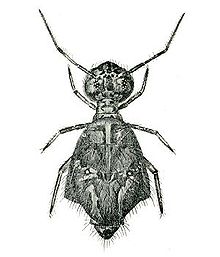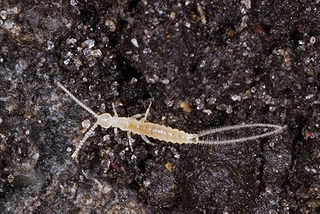
The order Diplura is one of three orders of non-insect hexapods within the class Entognatha. The name "diplura", or "two tails", refers to the characteristic pair of caudal appendages or filaments at the terminal end of the body.
Demeton-S-methyl is an organic compound with the molecular formula C6H15O3PS2. It was used as an organothiophosphate acaricide and organothiophosphate insecticide. It is flammable. With prolonged storage, Demeton-S-methyl becomes more toxic due to formation of a sulfonium derivative which has greater affinity to the human form of the acetylcholinesterase enzyme, and this may present a hazard in agricultural use.
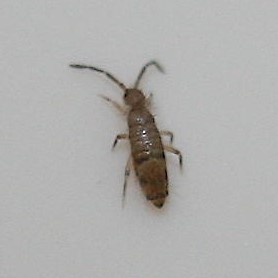
Entomobryidae, sometimes called "slender springtails", is a family of springtails characterised by having an enlarged fourth abdominal segment and a well-developed furcula. Species in this family may be heavily scaled and can be very colourful. The scale-less Entomobryidae are commonly caught in pitfall traps around the planet, and also occur in canopy faunas high up in trees. There are more than 1700 described species in Entomobryidae.
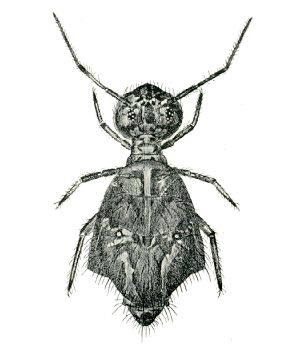
Sminthurus viridis is a member of the Collembola, the springtails, an order in the subphylum Hexapoda. The species is known by common names such as clover springtail, lucerne flea, or lucerne earth flea.

Mesostigmata is an order of mites belonging to the Parasitiformes. They are by far the largest group of Parasitiformes, with over 8,000 species in 130 families. Mesostigmata includes parasitic as well as free-living and predatory forms. They can be recognized by the single pair of spiracles positioned laterally on the body.
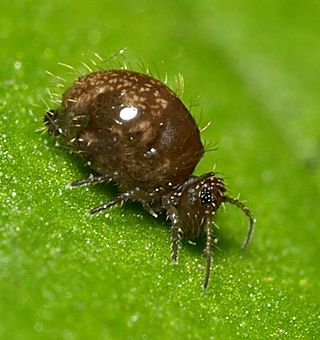
The order Symphypleona is one of the three main groups of springtails (Collembola), tiny hexapods related to insects. When the springtails were still believed to be an order of insects, the Symphypleona were ranked as a suborder.

The Entomobryomorpha are one of the three main groups (order) of springtails (Collembola), tiny hexapods related to insects. This group was formerly treated as a superfamily, the Entomobryoidea.

The Diplostraca or Cladocera, commonly known as water fleas, is a superorder of small, mostly freshwater crustaceans, most of which feed on microscopic chunks of organic matter, though some forms are predatory.
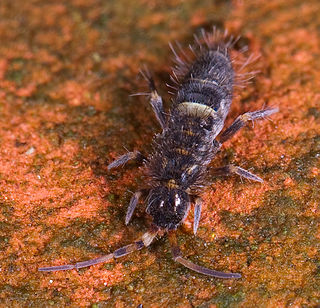
Springtails (Collembola) form the largest of the three lineages of modern hexapods that are no longer considered insects. Although the three orders are sometimes grouped together in a class called Entognatha because they have internal mouthparts, they do not appear to be any more closely related to one another than they are to all insects, which have external mouthparts.

Allacma fusca is a species of springtail. This species is endemic to western areas of Continental Europe and the British Isles, where it lives in the surface layers of the soil in moist habitats such as among leaf litter.

Many species of arthropods can bite or sting human beings. These bites and stings generally occur as a defense mechanism or during normal arthropod feeding. While most cases cause self-limited irritation, medically relevant complications include envenomation, allergic reactions, and transmission of vector-borne diseases.
Ascidae is a family of mites in the order Mesostigmata.

Chaetotaxy is the arrangement of bristles (macrochaetae) on an arthropod or annelid, or taxonomy based on their position and size. For example, it is important in Diptera, in which group it was formalised by Ernst August Girschner. The term chaetotaxy was later proposed by Carl Robert Osten-Sacken.

Folsomia candida is a species of springtail in the family Isotomidae. It is found in soil in many locations around the world, having been spread inadvertently by humans. It reproduces by parthenogenesis and has been used as a model organism in research.

Haplothrips is a genus of thrips in the family Phlaeothripidae. It is found worldwide and contains about 240 extant species.

Dicyrtomidae is a family of Collembola in the order Symphypleona, and it is the only family of the superfamily Dicyrtomoidea. It includes more than 200 species in eight genera.

Sminthurides is a genus of globular springtails in the family Sminthurididae. There are more than 30 described species in Sminthurides.

Sminthurididae is a family of globular springtails in the order Symphypleona. There are about 5 genera and more than 40 described species in Sminthurididae.
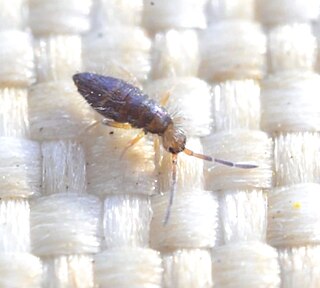
Willowsia buski, the damp grain springtail, is a species of slender springtail in the family Entomobryidae. It is found in abundance throughout North America and Europe, and likely has a cosmopolitan distribution. It can sometimes be found infesting stores of dry goods that have become contaminated with high moisture, giving rise to the name "damp grain springtail".

Neelidae is a family of springtails in the order Neelipleona. There are at least 4 genera and more than 30 described species in Neelidae.
